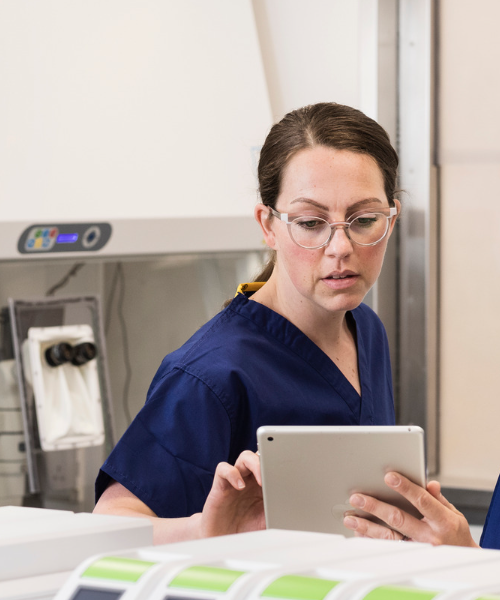Perimenopause, Fertility and IVF: What Every Woman Should Know
Perimenopause affects fertility through declining ovarian reserve and fluctuating hormones, often linked with low AMH. Early awareness enables timely fertility choices like IVF or egg freezing. Treatments including HRT support both conception and long-term health, helping women navigate this transition confidently.
By Mr Ed Coats, Consultant in Reproductive Medicine and Menopause Care
Introduction: why perimenopause matters for fertility and beyond
At The Evewell, we meet women at every stage of their reproductive journey. Some come to us in their twenties, planning ahead; many are in their thirties and forties, actively trying to conceive; others are exploring IVF or egg freezing. Increasingly, I also see women who are navigating the often-misunderstood world of perimenopause.
As a fertility doctor and menopause specialist, I know how closely these two areas overlap. Hormones drive both fertility and the menopause transition, and when levels begin to fluctuate, whether earlier than expected or right on time, the effects can be profound.
Understanding perimenopause is not only important for long-term health, but also critical for women with low AMH who are exploring fertility treatments such as IVF. This article aims to connect the dots: what perimenopause really is, how it impacts fertility, why early awareness matters, and how treatments like HRT (hormone replacement therapy) can support women both in their reproductive years and beyond.
What is perimenopause?
Let’s start with definitions.
- Menopause is defined as the point at which a woman, or a person with ovaries, has gone 12 months without a natural period. Although often described as a period of time, it’s actually only one day: after this day, the patient is considered postmenopausal.
- Perimenopause is the transition leading up to menopause, usually lasting between 4–10 years. It is during this phase that hormones fluctuate unpredictably, periods become irregular, and a wide range of symptoms can appear.
Rather than a slow, gentle decline in hormones, perimenopause is marked by dramatic rises and falls in oestrogen and progesterone. This is why symptoms can seem to come and go, vary in intensity, and mimic other conditions.
When does it begin?
The average age of menopause in the UK is 51. That means perimenopause typically begins in the early to mid-40s, though it can start in the late 30s for some women. By the late 40s, it’s almost statistically certain that hormonal changes are underway.
Why does perimenopause happen?
Every woman is born with a finite number of eggs. Unlike men, who continue to produce sperm throughout their lives, women’s egg supply declines steadily from birth.
As the ovarian reserve diminishes, so do levels of AMH (Anti-Müllerian Hormone), one of the key markers we use in fertility medicine. A low AMH level is often one of the first clues that the ovaries are entering a later stage of function, even if cycles are still regular.
The brain responds by sending stronger hormonal signals (FSH and LH) to the ovaries, trying to stimulate them to release an egg. But with fewer follicles left, the ovaries respond unpredictably. This mismatch between the brain and ovaries creates the erratic hormone swings we see in perimenopause.
The symptoms of perimenopause
Perimenopause is often described as a “zone of chaos” because of the wide-ranging symptoms it can cause. Common signs include:
- Cycle changes — periods may become heavier, lighter, closer together or further apart.
- Hot flushes and night sweats — sudden waves of heat that disturb daily life and sleep.
- Sleep problems and fatigue — difficulty falling or staying asleep.
- Mood changes — new anxiety, depression, irritability, or panic attacks.
- Cognitive symptoms — brain fog, memory lapses, difficulty concentrating.
- Physical changes — weight gain around the middle, joint and muscle pain, palpitations.
- Skin, hair and eye changes — dryness, thinning hair, itchy eyes.
- Sexual changes — reduced libido, vaginal dryness, discomfort with intimacy.
Not every woman will experience all of these, but for many, the impact on daily life is significant. Importantly, these changes can occur while a woman is still fertile, which brings us to the link between perimenopause and IVF.
Perimenopause and fertility: the AMH connection
In fertility medicine, AMH (Anti-Müllerian Hormone) is one of the most important markers of ovarian reserve. It reflects the number of eggs a woman still has.
- A high AMH suggests a good ovarian reserve, often seen in younger women.
- A low AMH indicates a reduced ovarian reserve, common in women in their late 30s and 40s, or in those approaching perimenopause.
For women with low AMH, the window for conceiving naturally is narrower. IVF may be recommended to improve the chances of pregnancy. However, declining ovarian reserve and fluctuating hormones make the process more challenging.
Does perimenopause mean pregnancy is impossible?
Not at all. Many women in perimenopause still ovulate — sometimes unpredictably, but ovulation does occur. I have seen women with very low AMH achieve successful pregnancies with IVF, donor eggs, or even naturally. But awareness is vital: the earlier you understand your hormonal status, the more options you have.
IVF in the context of perimenopause
When we design IVF treatment for women in perimenopause or with low AMH, we adapt protocols to maximise the chances of success.
- Personalised stimulation: Because the ovaries may be less responsive, we use tailored doses of medication to encourage follicle growth.
- Egg quality vs. quantity: Even with low AMH, it’s possible to retrieve good-quality eggs. Success often depends on quality rather than numbers.
- Donor eggs: For some women, particularly in later perimenopause, donor eggs may provide the highest chance of success.
- Supportive treatments: Managing perimenopausal symptoms with HRT or lifestyle changes can improve overall well-being during fertility treatment.
It’s important to recognise that IVF during perimenopause is not about “fighting biology” — it’s about working with the body in its current state, using medical support where needed.
HRT: beyond menopause symptom relief
When most people think of HRT (Hormone Replacement Therapy), they think of it as a treatment for hot flushes after menopause. But in reality, HRT plays a broader role.
For women in perimenopause:
- Stabilising hormones: Low-dose oestrogen and progesterone can smooth out the peaks and troughs of the hormonal rollercoaster.
- Protecting long-term health: HRT helps reduce the risks of osteoporosis and cardiovascular disease, which begin to rise during this stage.
- Supporting mental health: HRT can transform quality of life by reducing anxiety, improving sleep, and restoring balance.
For fertility patients, particularly those with low AMH:
- Optimising uterine environment: Oestrogen and progesterone can prepare the endometrium (uterine lining) for embryo implantation.
- Managing early ovarian decline: HRT may support women experiencing perimenopause earlier than expected, giving them more time to pursue fertility treatments.
- Supporting recovery after IVF: Hormonal support is often used to maintain pregnancy in the early weeks, particularly for women whose natural hormone levels are fluctuating.
Awareness gap: why women are left in the dark
One of the most striking issues in my practice is how few women know about perimenopause before they are in the middle of it. Medical education often stops once reproduction is discussed, leaving decades of female health under-addressed.
Women in their late 30s may be told they are “too young” for perimenopause, even as they struggle with symptoms. Others come for fertility treatment, only to discover that their low AMH and irregular cycles are early signs of ovarian decline.
This lack of awareness costs precious time. For fertility, earlier action can make the difference between having more treatment options or fewer. For health, it means women miss the chance to protect bones, heart and brain when they are most vulnerable.
What to do if you’re trying to conceive and worried about perimenopause
If you’re in your late 30s or early 40s, trying to conceive, and starting to wonder whether the symptoms you’re experiencing could be linked to perimenopause, the most important step is not to wait. Seek medical advice promptly. A fertility specialist can run tests, including AMH, FSH, LH and antral follicle count scans to give you a clearer picture of your ovarian reserve and where you may be in the transition. Acting early allows you to explore fertility options such as egg freezing or IVF while your ovaries are still producing eggs, or to plan for donor eggs if that becomes the most effective route.
At the same time, perimenopause symptoms can and should be treated, often with HRT or targeted support, so you don’t have to choose between pursuing fertility and feeling well. Taking action quickly can widen your options, reduce stress, and give you back a sense of control in what can otherwise feel like a very uncertain time.
Case reflections: fertility and perimenopause in real life
I recall one patient in her early 40s who came to us with very low AMH. She had noticed weight gain, anxiety and irregular cycles but had been told she was “too young” for perimenopause. We explained that her symptoms were indeed early hormonal changes and combined IVF treatment with HRT support. She achieved pregnancy on her second cycle and later told me that understanding her perimenopause gave her not just a baby, but peace of mind about her health.
Another patient in her late 30s was freezing eggs after discovering a low AMH. She hadn’t yet noticed symptoms, but her bloodwork showed she was entering the earliest phase of perimenopause. By acting early, she preserved fertility options and felt more in control of her future.
These examples highlight a key truth: knowledge is power.
From fertility to menopause, it’s one journey
Perimenopause is not a separate chapter from fertility — it is the natural continuation of the same story. Understanding your ovarian reserve, your AMH level, and your symptoms allows you to plan for both family and future health.
For some women, that means pursuing IVF with low AMH. For others, it means using HRT to stabilise symptoms and protect well-being. For all women, it means being informed and supported through every stage.
At The Evewell, our mission is to ensure women don’t face these transitions alone. Whether you are trying to conceive, freezing eggs, or navigating perimenopause, we are here to guide you with compassion, expertise, and evidence-based care.
You don’t have to choose between fertility and menopause support. With the right team, you can have both.





